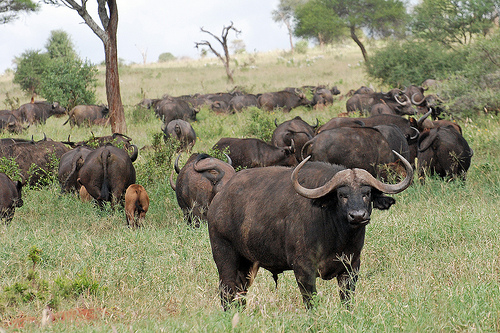African buffalo are too unpredictable, so they have never been tamed.
- African buffalo are stocky mammals, that look similar to cattle, and are native to areas south of Africa’s Sahara Desert.
- ‘African buffalo’ are also known as ‘Cape buffalo’, ‘Congo buffalo’, ‘savanna buffalo’, ‘widowmakers’ and ‘black deaths’, and are included in Africa’s ‘big five’ game animals that are the most dangerous and difficult animals to hunt, and are considered more dangerous than African lions, leopards and elephants, and black rhinoceros that make up the other ‘big five’.
- African buffalo have the scientific name of Syncerus caffer, being the only species in the genus, and are from the family Bovidae, the family of cloven hoofed (split into two toes) ruminants with non branching horns.
- African buffalo can grow up to 1.7 metres (5.6 feet) in height, up to 3.4 metres (11.2 feet) in length, and depending on habitat, have a weight of 250 to 900 kilograms (600 to 2000 pounds).
- There are four or five subspecies of African buffalo, and they typically have brown, black, brown-red or, if juveniles, red fur colour.
African Buffalo
Image courtesy of Harvey Barrison/Flickr
- The inward curving horns of African buffalo can grow up to 150 centimetres (5 feet) long, although forest buffalo, the smallest of the buffalo subspecies, have horns half that length, and on the male buffalo, the base of the horns extend across the head to form a shield, called a ‘boss’.
- The African buffalo diet consists mainly of grass, and they live in marshlands, savannahs, mountains, plains, grasslands and forests, in herds of 50 to 500 animals in savannah areas, and under 20 in forests.
- African buffalo are preyed on by lions, cheetahs, crocodiles, leopards hyenas, and humans, although they are only hunted by the experienced, as they are highly dangerous when threatened or attacked, and many people are killed each year by the buffalo.
- African buffalo make sounds of grunts, growls and other deep cow sounds.
- African buffalo typically have litters of one calf, and have a life span in the wild of around 20 years, although they can live up to 29 years.
Bibliography:
African buffalo, 2014, Wikipedia, http://en.wikipedia.org/wiki/African_buffalo
Quick Facts, 2013, Ultimate Ungulate, http://www.ultimateungulate.com/Artiodactyla/Syncerus_caffer.html







